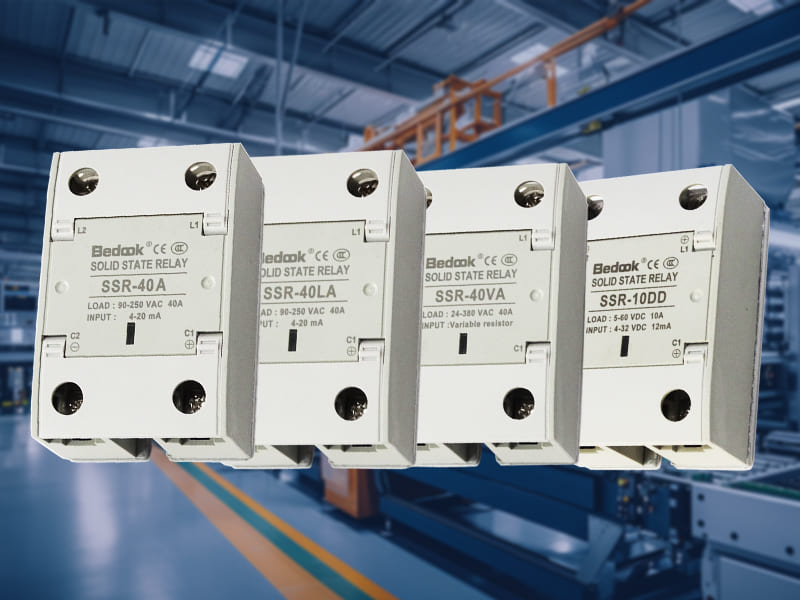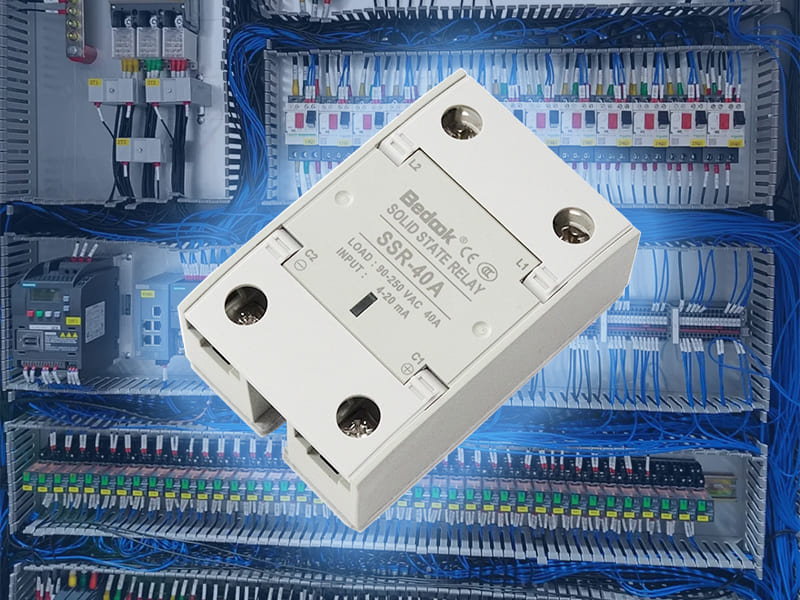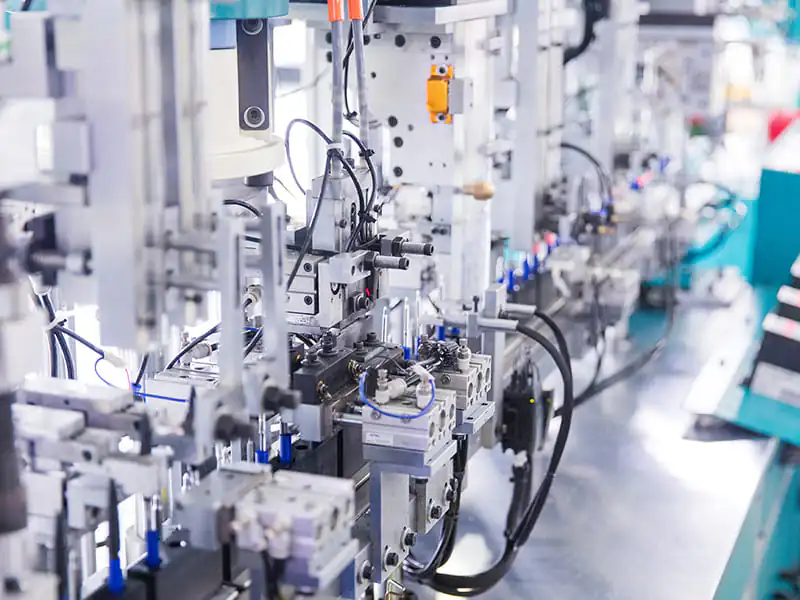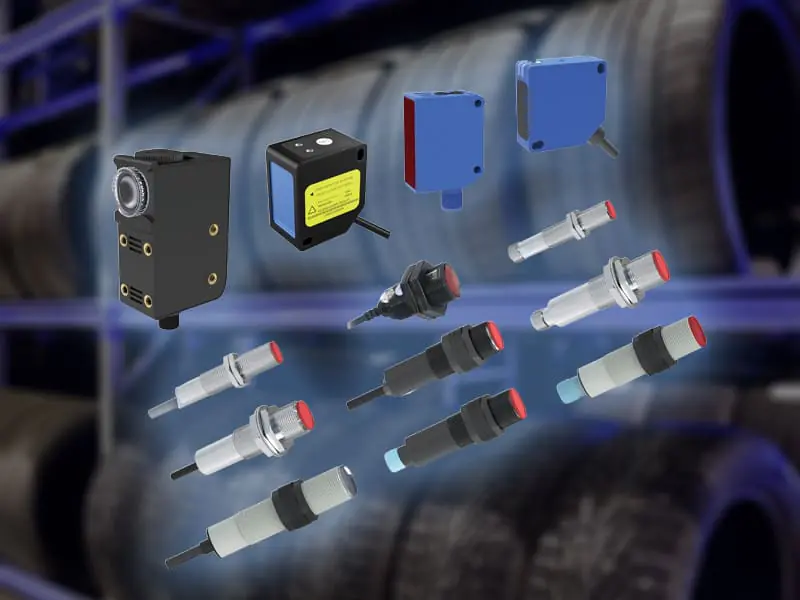A solid state relay (SSR) is an electronic device designed to control high-power circuits using low-voltage signals. Unlike electromechanical relays (EMRs), which use electromagnetic coils and physical contacts, SSRs operate without moving parts, making them silent, durable, and ideal for high-frequency operations.
-
Input Circuit:
- Receives a low-voltage control signal (e.g., 4–32V DC for Bedook SSR-DD series).
- Includes optocouplers to isolate the control circuit from the load, ensuring safety and reducing interference.
-
Opto-Isolation:
- A critical safety feature that uses light-emitting diodes (LEDs) and photodetectors to bridge the input and output circuits without direct electrical contact.
- Bedook SSRs comply with CE (EN60947-4-3) standards, ensuring isolation voltages up to 4kVrms.
-
Output Circuit:
- AC SSRs (e.g., Bedook SSR-A) use triacs or silicon-controlled rectifiers (SCRs) to handle alternating current.
- DC SSRs (e.g., Bedook SSR-D) employ MOSFETs or bipolar transistors for direct current applications.
When a control voltage is applied to the input:
- The optocoupler emits light, triggering the semiconductor in the output circuit.
- The semiconductor switches on, allowing current to flow to the load.
- Removing the control signal switches off the semiconductor, interrupting the current.
This process occurs in microseconds (e.g., Bedook SSR-LA achieves 1ms response time), enabling precise control in automation systems.
While electromechanical relays (EMRs) have served industries for decades, SSRs offer transformative advantages:
| Feature |
Solid State Relays |
Electromechanical Relays |
| Lifespan |
Up to 100 million operations (Bedook SSRs tested for 10+ years) |
1–10 million operations (mechanical wear) |
| Response Time |
Microseconds (Bedook SSR-DD: 1ms) |
Milliseconds (5–20ms) |
| Noise |
Silent operation |
Audible clicking (80–100dB) |
| Voltage Handling |
Up to 380V AC (Bedook SSR-A) or 120V DC (SSR-DD) |
Limited to 250V AC/30V DC |
| Surge Current Capacity |
160–520A (Bedook SSR-A series) |
10–50A (prone to contact welding) |
| Safety |
Opto-isolation and CE certification (Bedook) |
Risk of arcing and EMI interference |
SSRs excel in high-frequency applications (e.g., 10kHz switching for LED drivers), where EMRs would fail due to contact bounce.
Bedook Advantage: Bedook SSRs integrate fireproof ABS housing (UL94V0) and thermal protection, ensuring safe operation even in extreme conditions.
SSRs are indispensable across industries due to their adaptability and resilience:
-
Motor Control: SSRs like Bedook SSR-A series (10–70A) manage conveyor belts, pumps, and CNC machines.
- Case Study: A German automotive plant reduced downtime by 40% using Bedook SSR-70A for high-torque motor switching.
-
Heating Systems: Precise temperature regulation in furnaces and boilers via phase-controlled SSRs (e.g., Bedook SSR-LA).
- Solar Inverters: SSR-DD (5–120V DC) ensures efficient battery charging and discharge cycles.
- Wind Turbines: SSR-A’s surge protection (up to 520A) safeguards against grid fluctuations.
- MRI Machines: SSRs’ silent operation and EMI resistance (Bedook SSRs meet EN61000-4-4 standards) make them ideal for medical equipment.
- Electric Vehicles (EVs): SSR-DD manages battery packs, ensuring rapid switching during regenerative braking.
-
Phase Control:
- SSR-LA series adjusts power delivery by controlling the AC voltage phase angle, critical for applications like induction heating.
-
Zero-Crossing Switching:
- Bedook SSR-A models minimize EMI by switching at voltage zero-crossing points, ideal for sensitive electronics.
-
Thermal Management:
- SSRs generate heat during operation. Bedook’s optimized heat sink design ensures junction temperatures remain below 125°C.
Selecting an SSR depends on your application’s requirements:
-
Load Type:
- AC Loads: Choose SSR-A (24–380V) for general use or SSR-VA (phase control) for motor speed regulation.
- DC Loads: SSR-D (5–24V) for robotics or SSR-DD (5–120V) for heavy-duty applications.
-
Current Rating:
- Derate by 20% for continuous operation (e.g., 10A SSR handles 8A max long-term).
-
Control Voltage:
- Match input requirements (e.g., 4–20mA for SSR-LA or variable resistors for SSR-VA).
-
Environmental Factors:
- IP65-rated models (Bedook offers custom enclosures) for dusty/wet environments.
- Temperature range: -40°C to +80°C for SSR-DD series.
-
Safety Features:
- Look for CE (EN60947-4-3) and UL94V0 certifications for flame resistance.
-
Heat Sink Installation:
- Use thermal grease and secure mounting to ensure efficient heat dissipation. Horizontal installation reduces capacity by 50%.
-
Fuse Protection:
- External fuses are recommended (e.g., 1.5x rated current for Bedook SSRs) to protect against short circuits.
-
Environmental Monitoring:
- Avoid installing SSRs in areas with >85% humidity or conductive dust.
Solid state relays are critical components in modern automation, offering unmatched reliability and efficiency. By understanding their operation, advantages, and selection criteria, engineers can design robust systems. For those seeking advanced solutions,
Bedook’s SSRs combine technical excellence with rigorous testing, providing a trusted choice for diverse applications.
Extended reading:
Solid State Relay SSR Classification: A Must – Know for Electrical Projects
2025 Guide to Selection Single-Phase Solid State Relay
How Bedook Stands Out as a Trusted Solid State Relay Manufacturer
Explore Bedook: Your Trusted Sensor Manufacturer
At Bedook, we specialize in designing, developing, and manufacturing a comprehensive range of proximity sensors and switches. Our extensive product lineup includes:
With over 10,000 detailed product variations and a robust R&D team, we take pride in our ability to meet your unique requirements with tailored solutions and reliable performance.
Whether you’re seeking off-the-shelf products or customized designs, Bedook offers the expertise and production capacity to ensure your satisfaction.
We value your interest in our products and warmly encourage you to send us an inquiry. Let us help you find the perfect sensor solution for your application.
Thank you for considering Bedook—your trusted partner in innovation and quality manufacturing. We look forward to collaborating with you!






